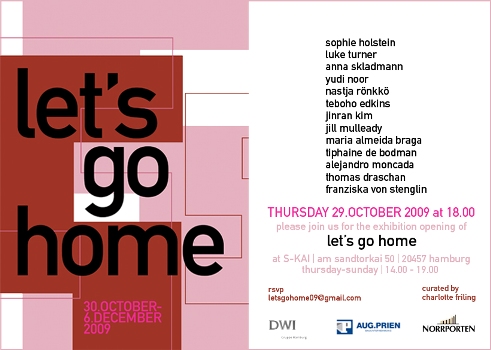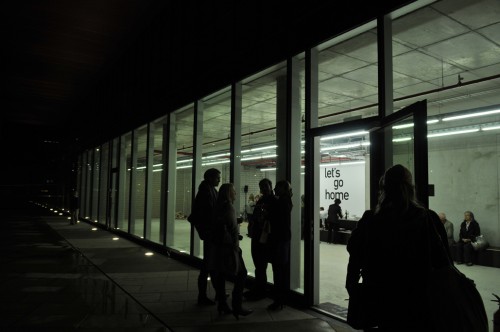An interview with the curator of Let’s go home – Charlotte Friling – by Maya Kolarova
Photo: Personal archive
How was the idea of such a show born?
I was approached by the artist, Sophie Holstein, and the first owners of the S-KAI building, DWI Grundbesitz GmbH, who wished to give young artists the chance to exhibit in a still unoccupied space of this stunning office block. Located in the brand new HafenCity district in Hamburg, I found the space ideal for a group show of international artists barely known to the public. The artists, just like the HafenCity landscape of recently popped-up architectural landmarks, would both challenge ‘local’ taste and order, and position themselves within it. We only had two months to set up the whole project!

Photo: Personal archive
Why did you choose S-KAI as a place to have the show?
We were very lucky to be offered the 800 square meters on the ground floor of S-KAI, still in its raw phase of construction. The whole space consisted of two separate rooms, which underwent minimal but striking changes. Franz von Wietersheim, a young architect based in Berlin, helped me shape this difficult space by covering up lines of unnecessary windows with MDF plates, which were then used as exhibition walls. We insisted upon leaving walls of concrete and white bricks bare, as well as wires, pipes and builders’ measurement tags. We were trying to achieve this brutal yet extremely graphic character of the space, all but the classic ‘white cube’. The light source we used was neon tubes taken from another floor of the construction site, which turned out perfect for an art exhibition. Just a few walls were painted white.
The exhibition space, which felt like it was still ‘under construction’, became an experience for viewers in itself. The artworks were installed in the complex rooms so as to invest their own space, allowing the viewer to be immersed in every artist’s own realm as well as to have breaks in between every artist ‘section’.

Photo: Personal archive
What drew your attention to the main topic – home? What angles is it represented from?
Calling the show ‘Let’s go home’ instead of only ‘Home’ was an obvious attempt to communicate the dynamics of the action, the idea of leaving, of going back. Something must have happened for us to make the step. The tone could be disillusion after a disastrous experience, or of tiredness, such as in ‘the party is over’. It could also be the cheeky one of two people liking each other!
‘Home’ is something that appeals to all of us. In the age of virtual reality, of globalization and perpetual movement, I felt the theme ‘home’ would be challenging because it can seem old-fashioned and yet we will never be free from it.
Going back home can mean returning to one’s roots and traditions. For this particular exhibition though, the 13 artists give us many more definitions.

Photo: Personal archive
Home can be a physical space, such as a house or a room. It is often linked to childhood, to memories of good or bad times. ‘Home’ is synonymous with human interaction and often with the formative starting point in life.
Home can also be a psychological or symbolic space, a memory or a feeling. Home could be defined as finding oneself and one’s balance.
As a conclusion, I’d say that for most of the artists and even for me, home is a space where ‘life’ goes on, a place to create.

Photo: Personal archive
Was it difficult to contact and convince all the artists to participate? Actually, how did you select them? What was your guiding principle?
Some of the selected artists were people I had spotted during my studies at Central Saint Martins in London and with whom I wished to work for a while. Others had been studying at Parsons and were introduced to me in the last months. A few caught my attention while I was living in Berlin.
I wished to work with people who take their careers seriously, who already produced a strong body of work no matter how young they are and from whom I could learn. The idea of the exhibition was to showcase excellent work, in a variety of media (we show painting, drawing, laser cuttings, collages, sculpture, photography, installation and film), exploring different definitions of the theme ‘Let’s go home’, so as to tell a story.

Photo: Personal archive
All were incredibly motivated right from the start and contributed a lot to the success of the show. I believe the concept of the exhibition appealed to them because of its universal theme and its great narrative potential, but also because of its location in Hamburg, a cultural center smaller than Berlin but just as edgy. The professional frame of the project also played an important role, supported by generous sponsors (DWI Grundbesitz GmbH, Aug. Prien Bauunternehmung and the Norrporten Group) and precious collaborations (Kunstverein Hamburg, Hafencity Hamburg,…).
What is your initial observation about the public reaction to the show – is it successful?
People and the press in Hamburg have shown great interest, curiosity and motivation, which has been fantastic! We also had many people travel from Berlin to see the show. There have been reviews about it on blogs, listings in Szene Hamburg, as well as articles in Die Welt and Die Welt Kompakt. Channel Hamburg 1 did a short film about the project which was shown on TV.
Visitors came in hundreds, drawn to ‘Let’s go home’ by listings or articles, but also while strolling around the neighborhood. Many of them, often not art connoisseurs, were intrigued and did not immediately understand the relation of some artworks to the theme. Our brochure, designed by graphic designer Christina Knapp Voith and with an explanatory press release as well as short texts about each artist illuminated most of them!

Photo: Personal archive
The show also served as a successful platform for these young talents to be exposed to critics, gallerists and collectors. We organized a large opening as well as guided tours and private views to allow people to get to know the artists and the stories behind the artworks.
My more global aim was to create a well curated, finely put together show that is well researched, documented and tells a story. That means that not all is obvious and that people have to go around the space as if playing a game, trying to interpret things and find the connections… Laying all out for them would be too easy!

Photo: Personal archive
Do you think the show achieved its original goal?
It achieved much more! Not only did we have the chance to attract fantastic people from Hamburg’s art world and general public, we also got a great deal of media attention as well as sold an amount of important works to savvy collectors. The S-KAI building showed itself in the best light and infused a lot of life in the HafenCity area. The most important achievement nonetheless was that all 13 artists collaborated in such a fantastic way and that we all learned a great deal from the project!

Photo: Personal archive
Are you satisfied with the results so far?
I’m infinitely thankful to DWI Grundbesitz GmbH and the other sponsors for giving me the opportunity to do what I love and for trusting me! I am very proud of this unexpected result, and glad I was allowed to collaborate with such fantastic artists… Watch them, they’ll make the front pages sooner than you think!

Photo: Personal archive
My final question to you – how do you, personally, perceive the home? What does it represent to you?
Home for me is family, warmth and trust. It is also an imaginary space within myself in which I can have a break from restlessness, in which I can focus and open doors of possibilities that would otherwise remain blocked. As a conclusion, home is this unique feeling of having arrived where you belong.

Photo: Personal archive
Thank you very much for this interview! I wish you luck with your future projects!
-
Let’s Go Home – a remarkable viewers’ experience
On Thursday 29th October the striking new S-KAI premises, designed by awarded architect team Jürgen Böge & Ingeborg Lindner-Böge and now temporarily an experimental space for art, will host its first ever art exhibition, Let’s Go Home.
Artists from a variety of backgrounds have been selected to showcase existing and specially commissioned works on S-KAI’s newly refurbished 800square metre surface, located in the heart of Hamburg’s revived HafenCity. The exhibition aspires to explore diverse and sometimes controversial definitions of ‘home’.
We usually relate ‘home’ to an orderly physical space and a central and stable starting point in life for children. Yet in Anna Skladmann’s reportage of privileged Russian kids, home is not synonymous with an innocent childhood, but is rather the complex stage on which these ‘little adults’ have to perform.
If for some, home triggers anxious memories of strife, for others it is a place of safety and love. In Teboho Edkins’ semi-fictional documentary, complicated and theatrical love in a Parisian apartment is ironically positioned beside scenes of what appears to be a ‘simpler’ love in Lesotho, Africa. With ‘In and Out of Love’, Maria Almeida Braga similarly explores love and the quest for balance. Jinran Kim’s ‘Soap Project’ also links ‘home’ to ‘intimacy’ by working with soap as symbol of our most intimate daily lives.
A home is also holder of memories. For ‘The Rock from underneath’, Franziska von Stenglin portrayed secluded Maltese homes crammed with paraphernalia, the repetition of objects resulting in a certain banality. She represents these photographed scenes in original display cabinets from the Natural History Museum, Berlin. Tiphaine de Bodman pushes the link to natural history even further with her meticulous drawings and cuttings that explore the idea of ‘home’ as the centre of the earth with its geological layers as the origin of life.
Inversely, Yudi Noor’s ‘Don’t think twice it’s a fake’ emphasises that a home is not only a centre, but that it is also a door to leave and re-enter through. A house that is nothing but a closed structure goes insane. The collages of Thomas Draschan playfully explore this idea of disrupted order and decadence.
What happens when the familiar becomes ‘uncanny’, when the house becomes ‘unheimlich’ ? In Sophie Holstein’s paintings, her characters seem to be victims of misunderstandings, both close and distant, on the edge of conflict. Similarly, Jill Mulleady’s interiors are fragmented spaces such as they would be in one’s memories, serving as boundaries between facts and fantasy.
In this age of the virtual, of globalisation and perpetual movement, homes of the old world are deconstructed and identities are weakened. More and more of us become ‘nomadic’, repositioning at every moment, redefining continually. Luke Turner’s film of a photograph evokes this transitory state of being betwixt and between, building up a tension between the fluidity of a moving image and the fixity of a photograph. Nastja Rönkkö evokes this ‘in-between’ two worlds in her somehow melancholic paintings, which declare that ‘home’ does no longer physically exist, but rather remains a distant sense.
For many, ‘home’ can therefore also be illustrated by a symbolic space, situated between the formless realm of insight and inspiration, and the external ‘reality’ of appearances. It is a space where ‘life’ goes on, a place to create and ultimately the place where we feel we belong.
Eventually, humans have to ‘arrive’, go to a place where life comes to a rest. With his ‘Blind Disco Ball’ which no longer reflects light, Alejandro Moncada announces: the party is over, let us go home.











No comments so far ↓
Nobody has commented yet. Be the first!
Comment